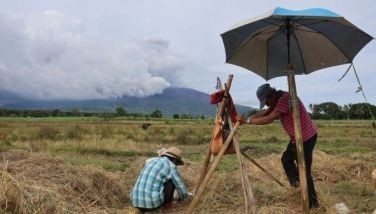Government needs to build 45,000 new classrooms
June 4, 2006 | 12:00am
An official of the Department of Education clarified yesterday that the government would actually need to build 45,000 new classrooms for students to have an ideal ratio of 45 students per classroom nationwide.
Mila Talinio of the DepEd’s planning and programming division said the classroom shortage of 6,832 that Acting Education Secretary Fe Hidalgo had mentioned earlier applied to a 1:100 classroom-to-student ratio under a "double-shifting" scheme implemented in all areas.
"We have different scenarios, one is the 1:45 single shift, the 1:50 double shift in selected areas and the 1:50 double shift in all areas. This has been calibrated. For 1:50 double shift in selected areas, we would have a 10,000-classroom shortage and for 1:50 double shift in all areas, it is 6,000-plus. For a 1:45 single shift, the shortage would reach up to 45,000," Talinio said.
She said she was not present when Hidalgo made her presentation before a Cabinet meeting last Tuesday, where the acting education secretary caught the ire of Mrs. Arroyo for failing to clarify the issue of classroom shortage.
Talinio said Hidalgo was highlighting the shortage but Mrs. Arroyo was expecting to be briefed on the progress being made to ease the problem.
Talinio noted the classrooms to be built within the year could already address the present shortage of 6,832 rooms.
Hidalgo earlier said she had failed to mention that around 2,600 new classrooms would be ready for use this June.
"Secretary Hidalgo was talking about the beginning while the President was talking about the end of the year," Talinio said. "It’s a matter of familiarity. It’s really us who handle the projections."
Without citing specific figures, Mrs. Arroyo conceded that the classroom shortage in the country must be given high priority.
During a televised roundtable discussion with Hidalgo, Talinio and the Commission on Higher Education Chairman Carlito Puno, Mrs. Arroyo said about 14,000 new classrooms have been built and 30,000 new teachers hired since she assumed office in 2001 as part of her program to improve the public school system.
She said she allotted P250 million for the early childhood education, which benefited at least 100,000 preschoolers.
Mrs. Arroyo added she had also ordered the distribution of high school vouchers to almost 400,000 students to enable them to study at private schools.
Mrs. Arroyo further said students who finished vocational and technical courses would be given credits toward attending college.
"We are also pushing for bigger funds for scholarships, and P500 million has been set aside for call center finishing schools and other courses that will help graduates find jobs easily," she said.
She said this was on top of scholarships given in colleges as well as vocational and technical schools. "And to ensure that they will be able to get high-tech jobs, we have special master’s degree programs."
Mrs. Arroyo emphasized the government should focus on education to make the Philippines more competitive in the 21st century.
"The government is doing everything to provide the youth with good education — the key to the country’s growth and our freedom from poverty," she said.
Mrs. Arroyo listed education as one of her top priorities at the start of a fresh six-year term last month, pledging full enrollment of school-age children and a computer in every classroom by 2010.
Business consultant Peter Wallace said education was the key to reducing poverty in a nation of 84 million where at least half the population lives on about P100 a day.
"The deterioration in the schooling system over the past two or three decades is frightening," he said, citing the dismal 8.4 percent passing rate of fresh Filipino information technology graduates in a Japan-sponsored competency test.
"Other Asians used to flock to the Philippines to learn. No more. Their colleges are better than ours. A poor primary and secondary education must take most of the blame."
Mila Talinio of the DepEd’s planning and programming division said the classroom shortage of 6,832 that Acting Education Secretary Fe Hidalgo had mentioned earlier applied to a 1:100 classroom-to-student ratio under a "double-shifting" scheme implemented in all areas.
"We have different scenarios, one is the 1:45 single shift, the 1:50 double shift in selected areas and the 1:50 double shift in all areas. This has been calibrated. For 1:50 double shift in selected areas, we would have a 10,000-classroom shortage and for 1:50 double shift in all areas, it is 6,000-plus. For a 1:45 single shift, the shortage would reach up to 45,000," Talinio said.
She said she was not present when Hidalgo made her presentation before a Cabinet meeting last Tuesday, where the acting education secretary caught the ire of Mrs. Arroyo for failing to clarify the issue of classroom shortage.
Talinio said Hidalgo was highlighting the shortage but Mrs. Arroyo was expecting to be briefed on the progress being made to ease the problem.
Talinio noted the classrooms to be built within the year could already address the present shortage of 6,832 rooms.
Hidalgo earlier said she had failed to mention that around 2,600 new classrooms would be ready for use this June.
"Secretary Hidalgo was talking about the beginning while the President was talking about the end of the year," Talinio said. "It’s a matter of familiarity. It’s really us who handle the projections."
Without citing specific figures, Mrs. Arroyo conceded that the classroom shortage in the country must be given high priority.
During a televised roundtable discussion with Hidalgo, Talinio and the Commission on Higher Education Chairman Carlito Puno, Mrs. Arroyo said about 14,000 new classrooms have been built and 30,000 new teachers hired since she assumed office in 2001 as part of her program to improve the public school system.
She said she allotted P250 million for the early childhood education, which benefited at least 100,000 preschoolers.
Mrs. Arroyo added she had also ordered the distribution of high school vouchers to almost 400,000 students to enable them to study at private schools.
Mrs. Arroyo further said students who finished vocational and technical courses would be given credits toward attending college.
"We are also pushing for bigger funds for scholarships, and P500 million has been set aside for call center finishing schools and other courses that will help graduates find jobs easily," she said.
She said this was on top of scholarships given in colleges as well as vocational and technical schools. "And to ensure that they will be able to get high-tech jobs, we have special master’s degree programs."
Mrs. Arroyo emphasized the government should focus on education to make the Philippines more competitive in the 21st century.
"The government is doing everything to provide the youth with good education — the key to the country’s growth and our freedom from poverty," she said.
Mrs. Arroyo listed education as one of her top priorities at the start of a fresh six-year term last month, pledging full enrollment of school-age children and a computer in every classroom by 2010.
Business consultant Peter Wallace said education was the key to reducing poverty in a nation of 84 million where at least half the population lives on about P100 a day.
"The deterioration in the schooling system over the past two or three decades is frightening," he said, citing the dismal 8.4 percent passing rate of fresh Filipino information technology graduates in a Japan-sponsored competency test.
"Other Asians used to flock to the Philippines to learn. No more. Their colleges are better than ours. A poor primary and secondary education must take most of the blame."
BrandSpace Articles
<
>
- Latest
- Trending
Trending
Latest
Trending
Latest
Recommended



























